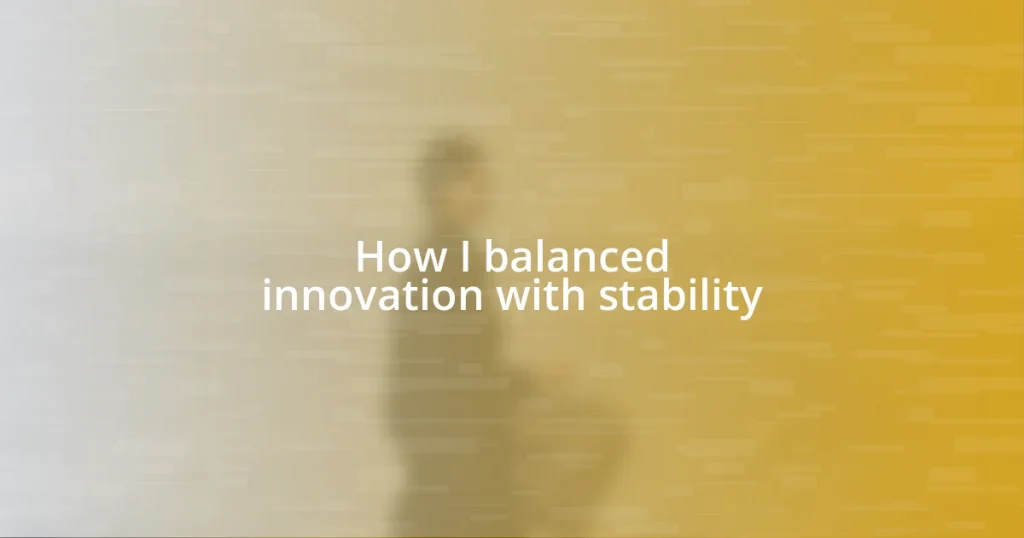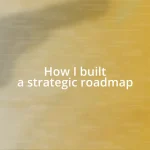Key takeaways:
- Balancing innovation and stability is essential for fostering a safe environment where teams can take calculated risks and explore new ideas without chaos.
- Implementing strategies like open communication, dedicated innovation time, and continuous learning helps nurture creativity while maintaining operational stability.
- Measuring the impact of innovation through both quantitative KPIs and qualitative feedback builds a culture of iteration and emphasizes the human aspect of innovative efforts.

Understanding innovation and stability
Innovation and stability might seem like opposing forces at first glance, but they actually intertwine in fascinating ways. I remember when I was tasked with launching a new product while ensuring the existing operations remained unaffected. That experience taught me that innovation thrives best in a stable environment, where the foundation is solid enough to support new ideas without overwhelming the team.
Thinking back on my career, I can’t help but wonder: how often do we confuse the need for change with the desire for chaos? Stability doesn’t stifle creativity; instead, it provides a safe space for risk-taking. I’ve seen teams flourish when they have clear processes in place, allowing room for experiments without the fear of failing dramatically.
Finding the right balance between innovation and stability is an art form. I often reflect on the moments when I embraced change but also leaned on reliable methodologies and frameworks. Those instances not only fostered growth but also strengthened our team’s resilience, highlighting how both elements can coexist and even enhance one another.

Importance of balancing both concepts
The importance of balancing innovation and stability cannot be overstated. I recall a time when my team was eager to implement a cutting-edge software tool. The enthusiasm was palpable, yet I knew we had a crucial legacy system to consider. By taking the time to integrate the new tool methodically, we avoided chaos and ensured that our daily operations continued smoothly. This experience reinforced my belief that a solid foundation allows innovation to flourish without risking the stability we’ve worked hard to achieve.
- A well-balanced approach encourages calculated risk-taking, enabling teams to explore new ideas while relying on existing strengths.
- Stability provides a safety net, fostering a culture where team members feel secure to voice their innovative thoughts.
- Balancing both concepts can enhance team morale, as individuals see their contributions lead to tangible advancements within a reliable framework.

Strategies for fostering innovation
One effective strategy I’ve found for fostering innovation is to encourage open communication within the team. I remember hosting brainstorming sessions where everyone was invited to share their ideas, no matter how unconventional. The atmosphere was electric with creativity, and I could see team members feeling empowered to contribute. It was fascinating how one simple invitation to speak up led to innovative solutions that would not have surfaced otherwise.
Another approach I value is setting aside dedicated time for innovation. In my experience, allocating specific hours for creative projects not only boosts morale but also nurtures a culture of experimentation. A while back, we established Innovation Fridays, a day where employees could work on passion projects. That initiative led to several successful improvements in our process, proving that giving time for innovation can yield significant benefits.
Finally, investing in continuous learning is essential to stay ahead. I’ve personally enrolled in workshops and encouraged my team to do the same. This commitment ensures we aren’t just resting on our laurels, but actively progressing and thinking outside the box. The evolution I’ve witnessed in my team’s capabilities has been truly rewarding, as they grow more confident and informed in pushing innovative ideas forward.
| Strategy | Description |
|---|---|
| Open Communication | Encouraging team members to freely share ideas fosters creativity and empowerment. |
| Dedicated Innovation Time | Having specific periods for creative projects promotes experimentation and can lead to improvements. |
| Continuous Learning | Investing in workshops and training ensures the team grows and stays informed on innovative trends. |

Maintaining operational stability practices
Maintaining operational stability requires a proactive mindset. I remember when our team faced unexpected technical challenges after a system update. Rather than reacting with panic, we quickly organized a series of support sessions where team members could share their insights and solutions. This collaborative effort not only resolved the issues faster but also bonded us as we navigated the turbulence together, reinforcing the notion that stability thrives in unity.
Having clear protocols in place is another vital practice I’ve learned. During a project rollout, establishing a checklist of procedures helped us maintain a steady course. I’ve seen firsthand how such frameworks reduce confusion, allowing team members to focus on their responsibilities without second-guessing. Doesn’t it feel reassuring to have a reliable roadmap guiding you through uncertainties? It empowers individuals to act with confidence while ensuring the overall operational flow remains intact.
Lastly, I’ve found that regularly revisiting and refining our operational practices fosters durability. In one instance, we conducted quarterly reviews of our processes, assessing what worked and what didn’t. This initiative not only highlighted areas for improvement but also showed the team that their feedback was valued. By creating that loop of ongoing improvement, we not only maintained stability but also nurtured a culture that embraced change, proving that operational resilience is a journey, not a destination.

Measuring the impact of innovation
Measuring the impact of innovation is crucial if you want to understand its effectiveness and long-term benefits. In my experience, one of the most revealing methods is to establish key performance indicators (KPIs) that align with our innovation goals. I recall implementing metrics like customer satisfaction scores and product usage analytics after launching a new feature. Seeing the tangible results reflected in those numbers validated our innovative efforts and motivated the team to keep pushing boundaries.
On a practical level, I often conduct post-implementation reviews to gauge the success of new initiatives. For instance, after introducing a streamlined workflow, we convened a feedback session to assess its effectiveness. The candid discussions revealed not only areas of success but also opportunities for further improvement. That moment of collective reflection transformed our innovation journey into a learning experience, fostering a culture that wasn’t afraid to iterate.
Moreover, I find qualitative feedback equally valuable. When we rolled out a new product, I made it a point to gather insights directly from our users. The stories they shared about how our innovation impacted their daily lives were incredibly moving. It felt like we weren’t just measuring success in numbers, but in genuine human experiences. Isn’t it fascinating how innovation can make a real difference, often beyond what the data can show? That emotional connection not only motivates me but also reminds the team why we innovate in the first place.

Case studies of successful balance
In my early days at a tech startup, I witnessed a striking example of balancing innovation with stability during our attempt to integrate AI into our customer service. Initially, we were met with resistance from the team, fearing that automating responses would alienate our users. To address this, we held a workshop where team members could express their concerns and share their creative ideas on improved service. This approach not only eased anxiety but also led to the development of a hybrid model that empowered our team while leveraging technology, striking a delicate balance between innovation and human touch.
Another instance stands out from a project involving a major system upgrade. I vividly recall rallying our cross-functional teams to align on their priorities ahead of the launch. We created a shared dashboard that displayed real-time metrics on system performance and user feedback, enabling us to adapt quickly. The excitement in the room during our daily stand-up meetings was palpable as successes were celebrated and challenges were tackled collectively. This open communication ensured we maintained stability while embracing the evolving landscape of our product.
Reflecting on these experiences, I can’t help but feel that the key to achieving a successful balance lies in cultivating a culture of trust and collaboration. I remember a particular moment when a team member suggested a radical change to our workflow that initially felt risky. Instead of shutting down the idea, we explored it together, leading to insights that reshaped our processes for the better. Isn’t it inspiring how a single suggestion can lead to profound enhancements while reaffirming our commitment to stability? It’s this kind of environment that has taught me that innovation and stability aren’t opposing forces; they’re two sides of the same coin.

Tips for ongoing adaptability
Embracing an adaptable mindset is essential for ongoing adaptability. One evening, while brainstorming solutions to a project setback, I realized the value of being open to change. This mindset allows teams to pivot when necessary, fostering a culture that embraces new ideas without losing sight of core values. Have you ever considered how small shifts in thinking can lead to significant breakthroughs?
In my experience, encouraging continuous learning among team members has been pivotal. I remember setting up a monthly ‘innovation day’ where everyone could explore any technology or idea that intrigued them. This initiative not only sparked creativity but also equipped the team with fresh perspectives, which proved invaluable when addressing unexpected challenges. It’s amazing how a little time devoted to exploration can create a springboard for future adaptability!
Lastly, active listening plays a crucial role in remaining adaptable. After a stakeholder meeting, I made it a point to circle back with the team about the feedback received. It became evident that voicing concerns often led to actionable changes we hadn’t considered before. How often do we overlook the power of listening in a fast-paced environment? This practice has taught me that adaptability is not just about reacting; it’s about collectively navigating the path forward with intent and awareness.















